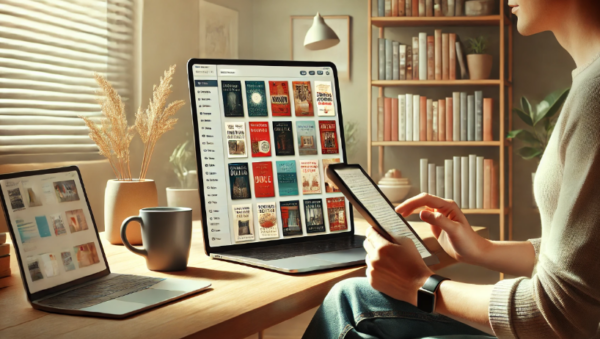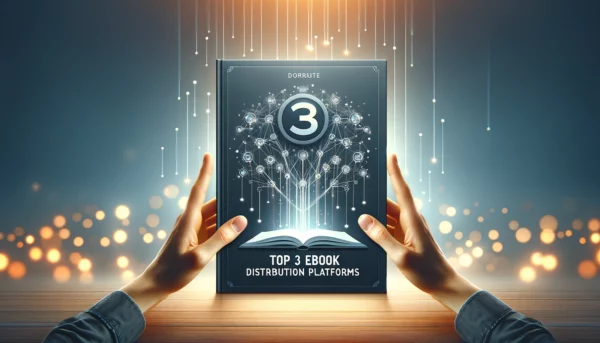Imagine your book as a grand ship, ready to sail the vast seas of readers’ imaginations. But before setting off, you face a classic publishing conundrum: Do you anchor your story to digital shores or let it drift to readers as a physical masterpiece? Each option has its own perks, pitfalls, and particularities, like picking between a top-tier yacht and a nostalgic sailboat for your journey.
The choice between digital and physical book distribution is not merely a decision—it’s a strategic adventure. In 2022, ebooks accounted for around 15% of global book sales, with digital’s popularity steadily growing. Meanwhile, the tactile allure of printed books is hard to deny, especially since 65% of readers still prefer physical books for their “unique smell and feel”. The ongoing debate between digital and print books highlights how consumer preferences influence the publishing and retail sectors. With these numbers in mind, let’s dive into the fine details, pros, cons, and key insights that’ll help you make the choice best suited for your authorial journey.
Understanding Book Distribution Options
Book distribution is a crucial step in the publishing process, as it determines how your literary masterpiece reaches its eager audience. With the rise of digital technology, authors and publishers now have a plethora of distribution options to choose from. Understanding these options is essential to making informed decisions about how to distribute books effectively.
There are two primary book distribution options: digital and print. Digital book distribution involves making ebooks available through online retailers, such as Amazon Kindle Direct Publishing, Apple Books, and Barnes & Noble Press. This method allows your book to be just a click away from readers around the globe. Print book distribution, on the other hand, involves printing and shipping physical copies of books to retailers, wholesalers, and customers, ensuring your book finds a home on bookshelves and in the hands of readers who cherish the tactile experience.
Self-publishing services, such as BookBaby and IngramSpark, offer authors a range of distribution options, including print-on-demand (POD) and ebook distribution. POD allows authors to print and distribute books as needed, eliminating the need for upfront costs associated with large print runs. Ebook distribution services, such as Kindle Direct Publishing and Smashwords, enable authors to reach a global audience through various online platforms. By leveraging these distribution services, self-published authors can navigate the publishing process with greater ease and efficiency.
Digital Book Distribution: Sailing the Virtual Seas
If you want to cast your book far and wide without worrying about weight (or shipping fees), digital book distribution is your first-class cabin. Through platforms like Amazon Kindle, Apple Books, and Google Play Books, you can reach global readers faster than you can say “page-turner.” To maximize your sales potential, it’s crucial to distribute your ebook through all the major retailers, including Kobo and iBooks, ensuring comprehensive market coverage and capturing audience segments in different regions. In fact, ebooks give independent authors and self-publishers access to audiences from South Korea to South America—all at the tap of a screen.
Digital distribution also scores eco-points. According to the Environmental Paper Network, a single ton of printed books can emit over 8,500 pounds of CO₂. By going digital, you’re choosing a greener route, preserving forests, and appealing to eco-conscious readers.
The Pros and Cons of Digital Book Distribution
Pros of Digital
- Global Reach: Think of digital formats as the jet-setters of the book world, bringing your story to readers worldwide in mere seconds.
- Cost Efficiency: Digital books save you from the “ink, paper, and postage” budget, allowing more funds to go towards eye-catching marketing and promotion.
- Instant Gratification: In today’s swipe-right society, readers love immediate access. Platforms like Kindle Unlimited offer instant reading satisfaction to millions of subscribers, including nearly half of U.S. readers.
Cons of Digital
- Piracy Risks: Your ebook could become the next blockbuster on the “black market” of downloads, affecting your royalty count. Additionally, the retail price of your book directly impacts your royalties and earnings, as platforms like Amazon and CreateSpace calculate royalties based on the list price after deducting their commission fees.
- Physical Absence: Let’s face it, digital books don’t look quite as impressive on your coffee table or library shelf.
If you’re all about budget-friendly options with a global footprint, digital may be your best bet. With Spines, you get AI-enhanced proofreading and formatting, so your digital book is polished to perfection and ready for readers worldwide.
Print Books Distribution: The Tangible Treasure
For those who envision their work displayed on bookshelves, carried in bookshops, or cherished as a physical object, print distribution is the crown jewel. Physical books are ideal for genres like children’s literature and non-fiction, where vibrant visuals and high-quality paper elevate the experience. Despite the increase in digital media, parents and educators favor physical children’s books for interactive reading experiences, reflecting the unique appeal and tangible quality these books provide. Besides, who doesn’t love the smell of fresh ink?
Your Publishing Journey Awaits – Start NowPrint distribution typically leans on print-on-demand (POD) services, like IngramSpark and Spines, where books are printed only when purchased. POD is like your very own printing genie, conjuring up your book without requiring a garage full of unsold copies. It’s budget-friendly, waste-free, and allows flexibility for indie authors seeking a quality product without the risk of overprinting.
The Pros and Cons of Physical Book Distribution
Pros of Physical
- Tangible Appeal: Printed books add a sense of gravitas to your work. Let’s be real—digital downloads don’t hold a candle to signed copies on a bookshelf or a bookstore display.
- Brick-and-Mortar Presence: Physical books make it to bookstores, libraries, and literary events, offering visibility in the physical world.
- Perfect for Visual Genres: Printed books shine for children’s books, cookbooks, and visually appealing genres that captivate readers.
Cons of Physical
- Higher Upfront Costs: Printing, warehousing, and shipping make physical books a bigger upfront investment, with industry estimates putting production costs for self-published print books around $5,000 to $10,000.
- Environmental Impact: Traditional printing takes a toll on resources, with millions of trees felled yearly for book production.
Print books require a bit more in the cost department, but with Spines’ print-on-demand services, you can manage this elegantly. And with AI-driven cover design included, your physical book will look as captivating as it reads.
Consumer Preferences and Market Trends
The book market is a dynamic landscape, constantly evolving with changing consumer preferences and technological advancements. Understanding these trends is essential for authors and publishers to make informed decisions about book distribution.
Reader Preferences: Digital vs. Print
Reader preferences play a significant role in determining the success of a book. While some readers revel in the tactile experience of print books, others appreciate the convenience and accessibility of digital books. According to a recent survey, 72% of readers still prefer print books, while 28% lean towards ebooks. However, the preference for digital books is on the rise, particularly among younger readers who are more accustomed to digital formats.
Demographic factors, such as age, income, and education, also influence reader preferences. Younger readers, for instance, tend to prefer digital formats, while older readers often favor the familiarity of print books. Additionally, higher-income readers are more likely to embrace digital formats, appreciating the convenience and portability they offer. By understanding these preferences, authors can tailor their distribution strategies to better meet the needs of their target audience.
Making the Choice: Which Format Fits Your Book?
The ultimate decision depends on your goals and your audience. Are you publishing an illustrated children’s book, or perhaps a visually rich coffee-table masterpiece? Or perhaps a mystery novel aimed at tech-savvy international readers? If you want budget-friendly reach, go digital. But for those eyeing a lasting, tangible impact, a physical book is ideal.
Many authors today use a hybrid approach, offering both digital and physical versions to capture the widest audience possible. Thanks to platforms like Spines, the offer of both formats has never been easier to find.
Self-Publishing Platforms: Where Indie Authors Shine
Self-publishing services have transformed the industry for independent authors. A self-publishing service offers comprehensive solutions, including manuscript conversion, professional editing, marketing assistance, and distribution across major retail platforms. Platforms like Spines, Amazon Kindle Direct Publishing, and IngramSpark simplify distribution, giving authors complete control over pricing, cover design, and royalties.
Print-On-Demand: No Wasted Paper, No Wasted Cash
Print-on-demand services like Spines have revolutionized publishing by enabling authors to print only what they need. This approach saves both money and the environment, with estimates showing POD can reduce waste by up to 75% compared to traditional bulk printing. It’s the ideal solution for indie authors who want quality without the risk of warehouses brimming with unsold copies.
Spines’ print-on-demand services make it possible to publish without breaking the bank. Our AI ensures the quality is top-notch, while POD eliminates the waste and costs associated with traditional print runs.
Ebook Distribution Platform: Your Path to Global Readership
In the digital world, platforms like Amazon Kindle, Apple Books, and Google Play Books act as highways to readers around the globe. Each platform offers unique benefits: Kindle Unlimited draws in nearly 4 million U.S. subscribers alone, while Apple Books is known for its extensive reach in affluent, tech-savvy markets.
Leveraging Both Formats: Hybrid Distribution Strategies
In today’s digital age, relying on a single distribution format is no longer sufficient. A hybrid distribution strategy, which combines both digital and print formats, can help authors reach a wider audience and increase their chances of success.
A hybrid distribution strategy involves making books available in both digital and print formats through various distribution channels. For example, an author can publish an ebook through Kindle Direct Publishing and also make a print version available through BookBaby’s POD service. This approach ensures that your book is accessible to readers who prefer digital formats as well as those who cherish the tangible experience of a print book.
By leveraging both formats, authors can cater to different reader preferences and increase their visibility in the market. Hybrid distribution strategies also enable authors to reach a global audience, as digital books can be easily distributed through online retailers, while print books can be shipped to customers worldwide. This dual approach maximizes your book’s reach and ensures that no potential reader is left behind.
Maximizing Sales: Essential Marketing Tools for Authors
Effective book marketing is vital, whether you choose digital, physical, or both formats. Digital platforms offer built-in promotional tools, from Amazon’s “freebie” days to countdown deals. Physical books, on the other hand, benefit from book signings, bookstore placements, and reader meet-and-greets.
At Spines, we recognize the importance of visibility. With our global distribution partnerships and built-in marketing tools, we help ensure your book stands out. Consider social media campaigns, paid promotions, or even influencer shoutouts to spread the word and boost visibility. In the end, marketing isn’t just an afterthought—it’s a critical step in making sure readers discover and engage with your work.
The Future of Book Distribution: Evolving Preferences and Technological Advancements
The future of book distribution is expected to be shaped by evolving reader preferences and technological advancements. As readers become increasingly comfortable with digital technology, the demand for digital books is likely to continue its upward trajectory.
Ebook distribution platforms, such as Kindle Direct Publishing and Smashwords, are expected to remain pivotal in the book market. These platforms offer unparalleled reach and convenience, simplifying the process for authors to connect with readers around the globe. However, traditional publishers are also adapting to the changing market by offering digital formats and experimenting with new distribution models.
The rise of audiobooks and podcasting is another trend that is expected to impact the book market. As readers increasingly seek out new ways to consume content, authors and publishers will need to adapt by offering audiobook versions of their books and experimenting with new formats, such as interactive ebooks and virtual reality experiences.
Ultimately, the future of book distribution will be shaped by the needs and preferences of readers. As technology continues to evolve, authors and publishers will need to be flexible and adaptable to ensure that their books reach their target audience effectively. By staying attuned to these trends and leveraging the latest distribution technologies, authors can navigate the ever-changing landscape of book distribution with confidence.
Digital and Physical Book Distribution: Choosing the Right Path for Your Story
Ultimately, the choice between digital and physical book distribution is a strategic one, based on your unique goals and readership. Digital books provide the global reach and affordability many indie authors need to gain traction, while physical books offer a lasting, tangible presence cherished by readers. For many authors, a mix of both provides the best balance, maximizing reach without losing that special, physical touch.
Ready to Publish? Let Spines Help You Share Your Story
When your manuscript is ready to reach readers, Spines offers the tools and support to make it happen seamlessly. Our blend of advanced AI and expert guidance transforms the publishing journey into a streamlined, affordable experience. From compelling cover design to global distribution, Spines ensures your story finds its audience.
So, which path will you choose for your story’s journey? The pages await—let Spines help you turn them into the reality of being a published author.
Your Publishing Journey Awaits – Start Now







